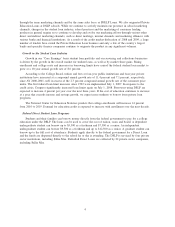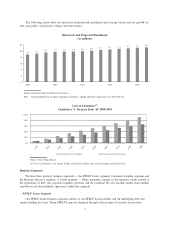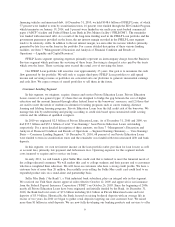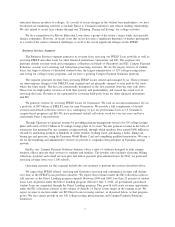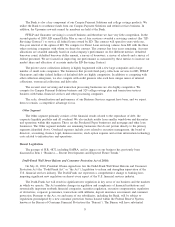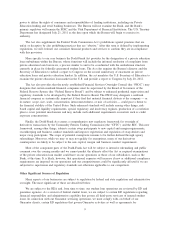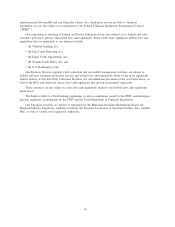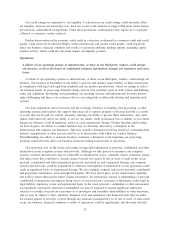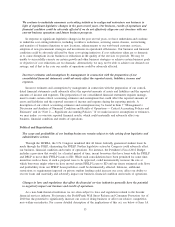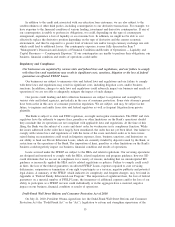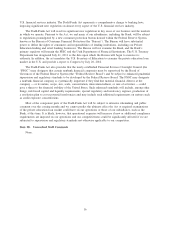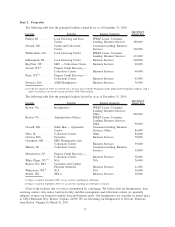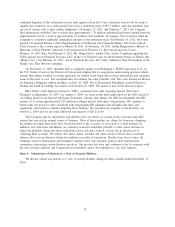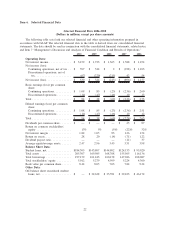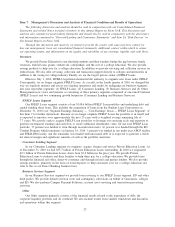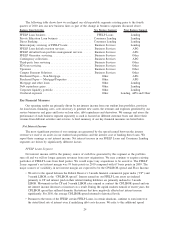Sallie Mae 2010 Annual Report Download - page 15
Download and view the complete annual report
Please find page 15 of the 2010 Sallie Mae annual report below. You can navigate through the pages in the report by either clicking on the pages listed below, or by using the keyword search tool below to find specific information within the annual report.“Risk Factors — Regulatory and Compliance.” In 2010, we were anticipating the introduction of the Troubled
Asset Relief Program (“TARP”) tax, which had the potential to significantly reduce our net income. The
President’s Fiscal 2012 Budget resubmits such a tax for Congress’ consideration. The passage of sweeping
changes to the legal and regulatory environments in which we operate, including increases in taxation or fees
charged on our business, have the potential to materially and adversely impact our business, financial condition
and results of operations.
Our ability to continue to grow our businesses related to contracting with state and federal governments
is partly reliant on our ability to remain compliant with the laws and regulations applicable to those
contracts.
We are subject to a variety of laws and regulations related to our government contracting businesses,
including our contracts with ED. In addition, these government contracts are subject to termination rights,
audits and investigations. If we were found in noncompliance with the contract provisions or applicable laws
or regulations, or the government exercised its termination or other rights for that or other reasons, our
reputation could be negatively affected, and our ability to compete for new contracts could be diminished. If
this were to occur, the future prospects, revenues and results of operations of this portion of our business could
be negatively affected.
Competition.
We operate in a competitive environment, and our product offerings are primarily concentrated in loan
and savings products for higher education.
We compete in the private credit lending business with banks and other consumer lending institutions,
many with strong consumer brand name recognition. We compete based on our products, origination capability
and customer service. To the extent our competitors compete aggressively or more effectively, we could lose
market share to them or subject our existing loans to refinancing risk. In addition, there is a risk that any new
education or loan products that we introduce will not be accepted in the marketplace. Our product offerings
may not prove to be profitable and may fail to offset the loss of business in the education credit market.
We are a leading provider of saving- and paying-for-college products and programs. This concentration
gives us a competitive advantage in the marketplace. This concentration also creates risks in our business,
particularly in light of our concentration as a private credit lender and servicer for the FFELP and DSLP. If
population demographics result in a decrease in college-age individuals, if demand for higher education
decreases, if the cost of attendance of higher education decreases, if public resistance to higher education costs
increases, or if the demand for higher education loans decreases, our private credit lending business could be
negatively affected. In addition, the federal government, through the DSLP, poses significant competition to
our private credit loan products. If loan limits under the DSLP increase, as they did in late 2007 and 2008,
DSLP loans could be more widely available to students and parents and DSLP loan limits could increase,
resulting in a decrease in the size of the private credit education loan market and lessened demand for our
private credit education loan products.
Credit and Counterparty.
Unexpected and sharp changes in the overall economic environment may negatively impact the
performance of our loan and credit portfolios.
Unexpected changes in the overall economic environment may result in the credit performance of our
loan portfolio being materially different from what we expect. Our earnings are critically dependent on the
evolving creditworthiness of our student loan customers. We maintain a reserve for credit losses based on
expected future charge-offs which considers many factors, including levels of past due loans and forbearances
and expected economic conditions. However, management’s determination of the appropriate reserve level may
under- or over-estimate future losses. If the credit quality of our customer base materially decreases, if a
market risk changes significantly, or if our reserves for credit losses are not adequate, our business, financial
condition and results of operations could suffer.
14


